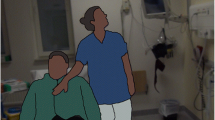Abstract
In their journey to becoming doctors, students engage with a range of teachers and trainers. Among these are simulated patients (SPs), who, through role-playing, assist students to develop their communication and physical examination skills, in contexts of formative and summative assessments. This paper explores the teaching and learning relationship between medical students and SPs, and considers how this might affect feedback and assessment. 14 SPs were interviewed on the subject of medical students’ professional identity development in 2014. Data were examined using narrative analysis in conjunction with positioning theory to identify the positions that SPs assigned to themselves and to students. Narrative analysis yielded three interpretative positioning themes: Occupational, familial and cultural and discursive and embodied positioning. The interview process revealed that SPs adopt different positions intra-and interpersonally. SPs appear to hold dissonant perceptions of students in terms relating to their emerging professional identities, which may confound assessment and feedback. Training should include reflections on the SP/student relationship to uncover potential biases and positions, giving SPs the opportunity to reflect on and manage their individual and occupational selves.

Similar content being viewed by others
References
Andreouli, E. (2010). Identity, positioning and self-other relations. Papers on Social Representations, 19(14), 1–3.
Burr, V. (2003). Social constructionism (2nd ed.). London: Routledge.
Costello, C. Y. (2005). Professional identity crisis: Race, class, gender and success at professional schools. Nashville: Vanderbilt University Press.
Cruess, R. L., Cruess, S. R., Boudreau, J. D., Snell, L., & Steinert, Y. (2014). Reframing medical education to support professional identity formation. Academic Medicine, 89(11), 1446–1451. doi:10.1097/ACM.0000000000000427.
Cruess, R. L., Cruess, S. R., Boudreau, J. D., Snell, L., & Steinert, Y. (2015). A schematic representation of the professional identity formation and socialization of medical students and residents: A guide for medical educators. Academic Medicine, 90(6), 718–725. doi:10.1097/ACM.0000000000000700.
Davies, B., & Harré, R. (2007). Positioning: The discursive production of selves. Journal for the Theory of Social Behaviour, 20(1), 43–63.
Duveen, G. (1993). The development of social representations of gender. Papers on Social Representations, 2(3), 171–177.
Gawande, A. (2010). The checklist Manifesto. New York: Metropolitan.
Gergen, K. (1985). The social constructionist movement in modern psychology. American Psychologist, 40(3), 266–275.
Harré, R., & Van Langenhove, L. (1991). Varieties of positioning. Journal for the Theory of Social Behaviour, 21(4), 393–407. doi:10.1111/j.1468-5914.1991.tb00203.x.
Kurtz, S. M., Silverman, J. D., & Draper, J. (1998). Teaching and learning communication skills in medicine. Oxford: Radcliffe Medical Press.
Labov, W. L., & Waletzky, J. (1967). Narrative analysis. In J. Helm (Ed.), Essays on the verbal and visual arts (pp. 12–44). Seattle: University of Washington Press.
McLean, M., Johnson, P., Sargeant, S., & Green, P. (2015a). Simulated patients’ perspectives of and perceived role in medical students’ professional identity development. Simulation in Healthcare: The Journal of the Society for Simulation in Healthcare, 10(2), 85–91.
McLean, M., Johnson, P., Sargeant, S., & Green, P. (2015b). More than just teaching procedural skills: How RN clinical tutors perceive they contribute to medical students’ professional identity development. Australasian Medical Journal, 8(4), 122–131. doi:10.4066/AMJ.2015.2326.
McNaughton, N., Tiberius, R., & Hodges, B. (1999). Effects of portraying psychologically and emotionally complex standardized patient roles. Teaching and Learning in Medicine: An International Journal., 11(3), 135–141.
Moghaddam, F., & Harré, R. (2010) Words, conflicts and political processes. In F. Moghaddam & R. Harré (Eds.), Words of conflict, words of war: How the language weuse in political processes sparks fighting. Santa Barbara, CA: Praeger.
Monrouxe, L. V. (2009). Negotiating professional identities: Dominant and contesting narratives in medical students’ longitudinal audio diaries. Current Narratives, 1(1), 41–59.
Murray, M., & Sargeant, S. (2012). Narrative psychology. In D. Harper & A. Thompson (Eds.), Qualitative research methods in mental health and psychotherapy (pp. 163–175). Chichester: Wiley.
Nestel, D., Clark, S., Tabak, D., Ashwell, V., Muir, E., Paraskevas, P., & Higham, J. (2010). Defining responsibilities of simulated patients in medical education. Simulation in Healthcare: The Journal of the Society for Simulation in Healthcare., 5(3), 161–168. doi:10.1097/SIH.0b013e3181de1cb6.
Nightingale, D. J., & Cromby, J. (1999). Social constructionist psychology: A critical analysis of theory and practice. Buckingham: Open University Press.
Phillips, D., & Hayes, B. (2008). Securing the oral tradition: Reflective positioning and professional conversations in midwifery education. Collegian, 15(3), 109–114.
Redman, C. (2013). Agentive roles, rights and duties in a technological era. In R. Harré & F. Moghadamn (Eds.), The psychology of friendship and enmity: Relationships in love, work, politics, and war (pp. 109–128). ABC-CLIO: California, CA.
Riessman, C. K. (1993). Narrative analysis. London: Sage.
Slocum-Bradley, N. (2008). Discursive production of conflict in Rwanda. In F. Moghaddam, R. Harré, & N. Lee (Eds.), Global conflict resolution through positioning analysis (pp. 207–226). New York: Springer.
Wald, H. S. (2015). Professional identity (trans)formation in medical education: Reflection, relationship, resilience. Academic Medicine, 90(6), 1–6. doi:10.1097/ACM.0000000000000731.
Acknowledgments
The Authors wish to acknowledge Heather James for administrative assistance with this project.
Author information
Authors and Affiliations
Corresponding author
Ethics declarations
Conflict of interest
The Authors report no conflict of interest.
Rights and permissions
About this article
Cite this article
Sargeant, S., McLean, M., Green, P. et al. Applying positioning theory to examine interactions between simulated patients and medical students: a narrative analysis. Adv in Health Sci Educ 22, 187–196 (2017). https://doi.org/10.1007/s10459-016-9691-8
Received:
Accepted:
Published:
Issue Date:
DOI: https://doi.org/10.1007/s10459-016-9691-8




